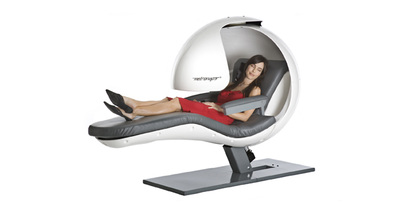|
Sure we could all use a little extra sleep after losing an hour to Day Light Savings. Scientific research has concluded afternoon naps for adults are beneficial. They increasing productivity, wakefulness, performance, and learning, along with a wide range of health benefits. Naps should range between 10 to 30 minutes, where anything longer unfortunately has adverse effects. Following this medical discovery a wide range of napping products have entered the market, many of which are just as useless and relevant as Day Light Savings.
Companies like Google and Procter & Gamble have embraced the nap by installing nap rooms and nap chairs. The nap is nothing new, European cultures have siestas everyday, where places of businesses close following lunch. Now for there's a solution for the tired yet ambitious go-getter, iNap. This app allow you to fake productivity while getting your sleep on. So after having an all night binder, this free app plays computer typing sounds, mouse clicking, the crumpling of paper, pencil sharping, and stapling tunes. If only it did the actual work and got rid of you undeniable hangover, blood shot eyes, breath of death, alcohol seeping out your pores, and your overall disheveled appearance. Although significantly less discreet, another solution may be the Ostrich Pillow. This napping device is essentially a pillow-like ski mask that costs $116. Sure you'll need a separate suitcase for lugging this thing around, all-the-while you're announcing to the world what a lazy fuck you are. Not to mention you'll look like a complete imbecile when your boss bursts into your office or you run into an Ex-whatever at the airport. The Ostrich Pillow received it's initial start-up costs of $100K via Kickstarter to enter the in the minuscule market of a bag over the head. It's hard to believe people backed this, but it could be only a matter of time before the trend catches on and offices supply them. So prepare your purchase orders for the Office Depot, Staples, WB Mason ostrich mask.
0 Comments
Leave a Reply. |
LAJ
100 Objects of Popular and Material Culture is an blog exploring the manifestations of human consumption and commodity-ization. The purpose of this experiment is to explore material and popular culture in contemporary society by using objects and concepts to prompt wider questions and reflections. So by emulating The British Museum's and Neil MacGregor's format of A History of the World in 100 Objects I plan to satirically analyze and reinterpreted 100 material culture objects over the course of 2014. Material Culture is the study of our culture's consumption of stuff; namely the manifestation of culture through material productions where people's perceptions of objects is socially and culturally dependent. With this, objects reflect conscious and unconscious beliefs on the the individuals who fabricated, purchased, or used them, and by extension the society where they live. So examining materiality, cultural truths and societal assumptions may be discovered. As anthropologist Arjun Appaduai states "in any society the individual is often caught between the cultural structure of commodity-ization and his own personal attempts to bring a value and order to the universe of things." Objects and commodities make up a much larger symbolic system consisting of want and need, socio-economic status, fashion, etc. Often times form follows function whether the commodity, market, and or consumer forever evolve around one-another. Philosopher Pierre Bourdieu's theories of capital flow full circle; where regardless if you are a minimalist or a hoarder the world is made up of things and everyone will leave their footprint on the earth. So by humorously analyzing marketed objects and concepts, hopefully this blog will provide further incite into ideas of over-consumption, a disposable society, consumerism vs. anti-consumers, planned obsolescence vs. sustainability, as well as the greater good of mankind and future generations. Archives
March 2015
Categories |



 RSS Feed
RSS Feed